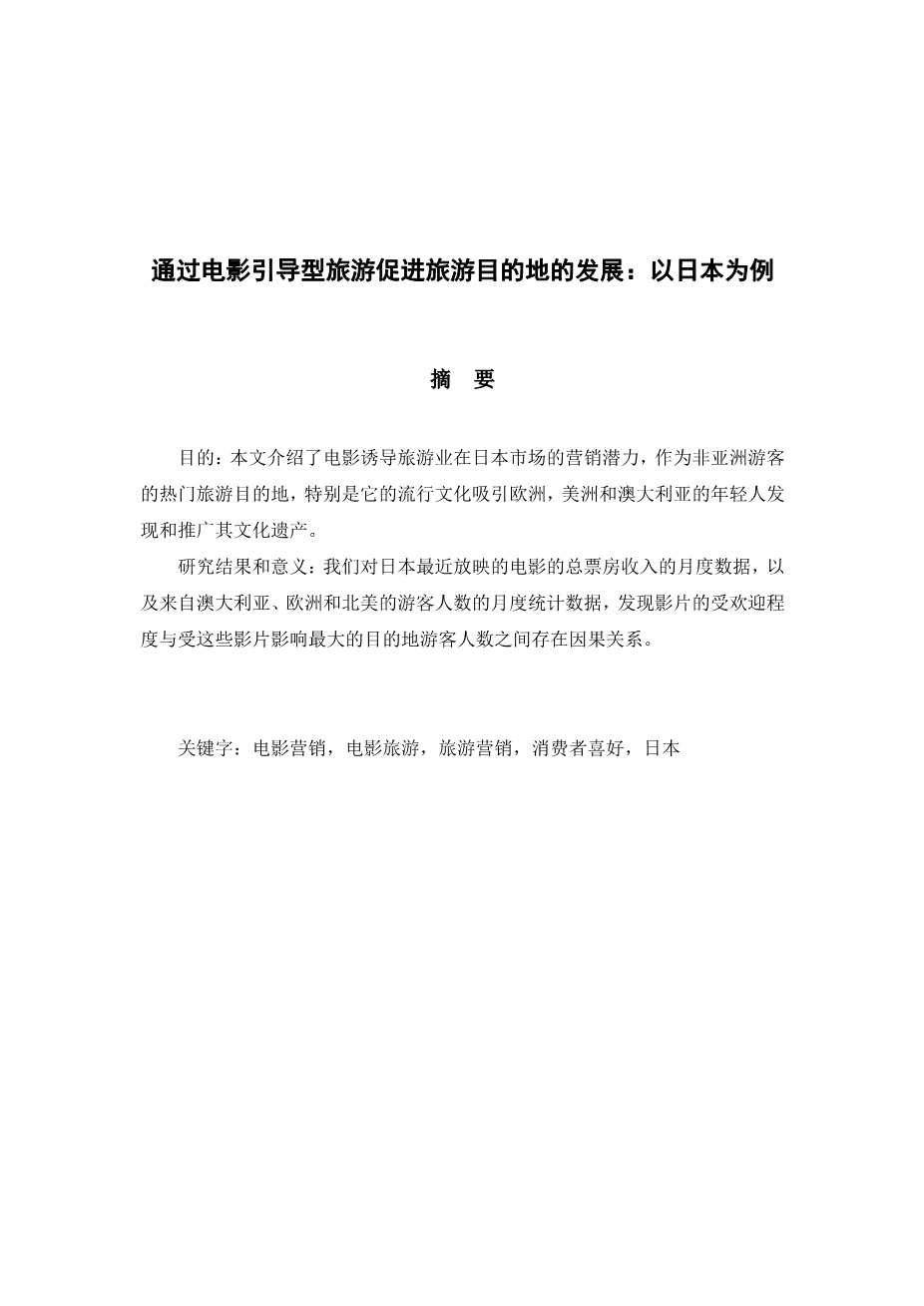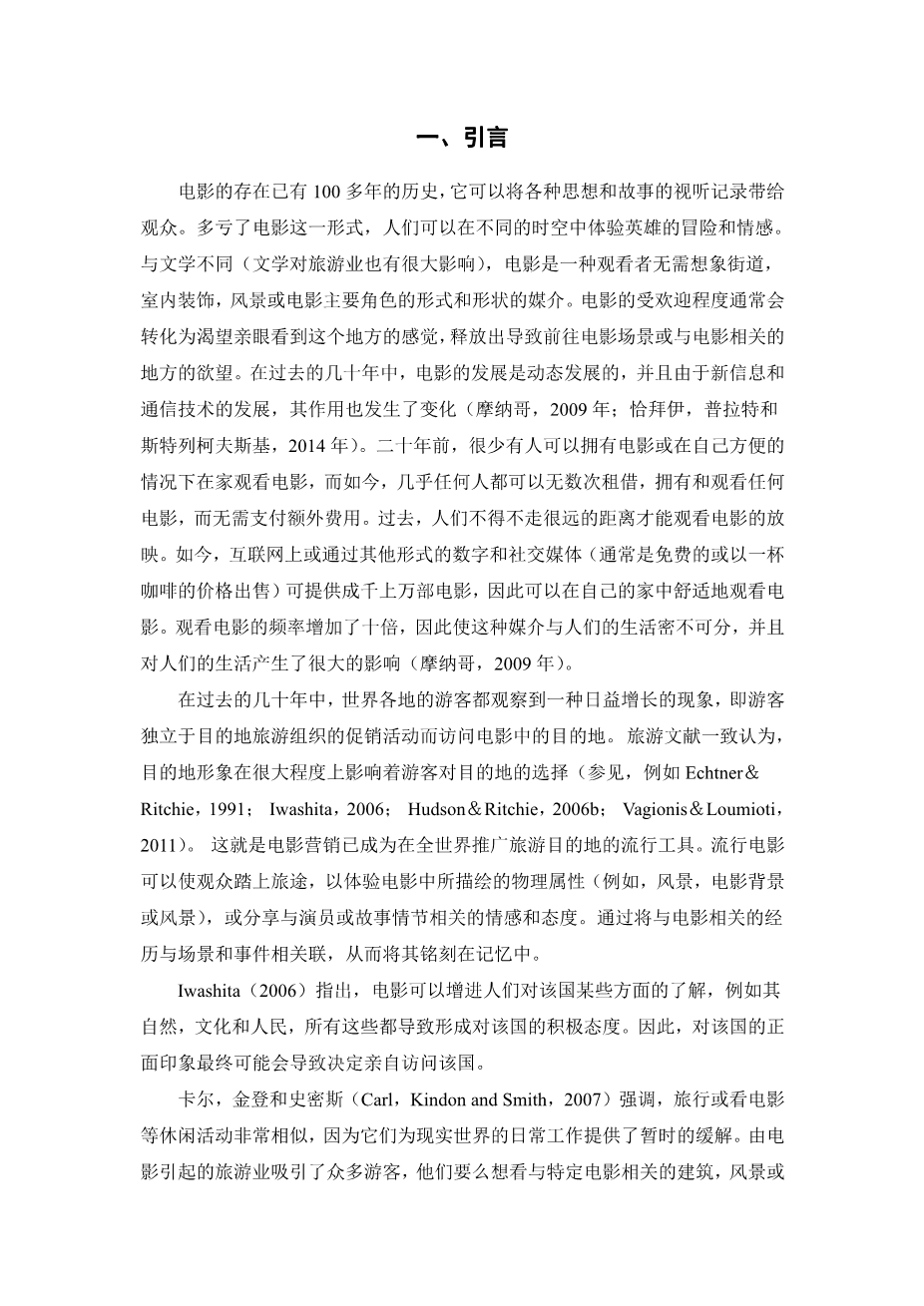PROMOTING TOURISM DESTINATION THROUGH FILM-INDUCED TOURISM: THE CASE OF JAPAN
Abstract
Purpose – This paper describes the marketing potential of film-induced tourism in marketing Japan, as a popular tourism destination for non-Asian visitors. In particular, it focuses on the popular culture and on engaging young people from Europe, America, and Australia in discovering and promoting its cultural heritage.
Findings and implications – We employ the monthly data on the combined box office revenues of recent films set in Japan, as well as the monthly statistics on the number of visitors from Australia, Europe, and North America. We find causality between the popularity of the films and the number of tourists from the destinations that are mostly impacted by those films.
Keywords film marketing, film-induced tourism, tourism marketing, consumer preferences, Japan
1. INTRODUCTION
For more than 100 years of its existence, film has allowed bringing to the audience the audiovisual capture of various ideas and stories. Thanks to the film, people can experience the adventures and emotions of heroes in distant time and space. Unlike literature (which also has a very strong influence on tourism and travel), the film is a medium that its viewer does not have to imagine the form and the shape of the streets, interiors, scenery, or the main protagonists of the film (Herbert, 2001; Hudson amp; Ritchie, 2006a; Roesch, 2009; Connell, 2012; Orsquo;Connor amp; Kim, 2014). The popularity of the film often translates into a desire to see the place in person, unleashing the emotions that lead to a desire to travel to the film setting or to the place associated with the film. For the past several decades, film-making has evolved dynamically and its role has changed thanks to the development of new information and communication technologies (Monaco, 2009; Chiabai, Platt amp; Strielkowski, 2014). Twenty years ago, few people could own films or watch them at home at their own convenience, whereas today almost anyone can rent, own, and watch literally any film a countless number of times at no additional expense. In the past, people had to travel considerable distances to watch a screening of a film. Nowadays, there are thousands of movies readily available on the Internet or via other forms of digital and social media (quite often free of charge or at a price of a cup of coffee), so films can be watched in comfort of onersquo;s own home. The frequency of film watching has increased tenfold, thus making this medium inseparable from and very influential on peoplersquo;s lives (Monaco, 2009).
In the past few decades, a growing phenomenon has been observed all around the world when tourists visited destinations featured in films independently of destination tourism organizationsrsquo; promotional campaigns. The tourism literature unanimously agrees that destination image largely influences touristsrsquo; choice of destinations (see, e.g. Echtner amp; Ritchie, 1991; Iwashita, 2006; Hudson amp; Ritchie, 2006b; Vagionis amp; Loumioti, 2011). This is how film marketing has become a popular tool for promoting tourism destinations all around the world.
Popular films can make the viewers embark on a travel in order to experience the physical properties depicted in the film (e.g. sceneries, films settings, or landscapes), or to share the emotions and attitudes linked to the actors or the storyline. Film-associated experiences are inscribed into the memory by associating them with the settings and events (see Iwashita, 2006; Hudson amp; Ritchie, 2006a; Hudson amp; Ritchie, 2006b).
Iwashita (2006) points out that a film can increase knowledge of certain aspects of the country, such as its nature, culture, and people which all result in the formation of positive attitudes towards the country. In turn, a positive image of the country might eventually lead to the decision to visit that country in person.
Carl, Kindon and Smith (2007) stress that such leisure activities as travelling or watching films are quite similar, since they provide a temporary relief from the daily routine of the real world. Film-induced tourism draws the crowds of tourists who either want to see the architecture, sceneries, or landscapes associated with particular films, or who are interested in experiencing the stories and themes associated with the places depicted in the films in a bid to grasp the immeasurable genius loci or to enjoy the intangible cultural heritage of the cities or rural landscapes.
With regard to that, one can mention the “push” and “pull” factors of film-induced tourism: while the push factor would be the possibility to take a break, as described by Carl and others (2007), the pull factorrsquo;s impact is more complicated. It can be shown that film locations do not employ classic marketing and advertising but communicate with customers through the medium which can affect the human brain at a subconscious level. The viewers are brought to an emotional state that can hardly be achieved by classic advertising while the context of the stories is offered on various sites that emotionally resonate with movies and easily arouse a desire to visit them.
Schama (1996) shows that people tend to attach both images and their personal projections to the events, locations, and actors seen in the films. Such images and projections enhance the obsession with the locations, making them iconic attractions as a result of attributing a powerful meaning to film narrations.
This paper is structured as follows: section 2 provides a comprehensive review of the tourism marketing research literature on the film-induced tourism. Section 3 describes the film-making either set in o
剩余内容已隐藏,支付完成后下载完整资料


英语译文共 8 页,剩余内容已隐藏,支付完成后下载完整资料
资料编号:[410176],资料为PDF文档或Word文档,PDF文档可免费转换为Word
您可能感兴趣的文章
- COVID-19时期的旅游业和可持续发展:以西班牙为例外文翻译资料
- 农民相对剥夺感对乡村旅游可持续发展的影响机制外文翻译资料
- 校园大学生的旅行行为——以亚洲某乡村大学为例外文翻译资料
- 内容旅游与地方社区响应:鹫宫的“幸运之星”和“协作动漫旅游”外文翻译资料
- 基于符号互动理论的遗产旅游资源开发与重塑——以良渚古城遗址为例外文翻译资料
- 在TikTok上映射互联网名人:探索注意力、经济和可见性劳动力外文翻译资料
- 基于社区游客视角的环境责任行为的概念和度量外文翻译资料
- 温泉小镇的再造:维希的独特案例——副标题外文翻译资料
- 基于IP理念的桐乡丰子恺文化旅游开发研究外文翻译资料
- 特殊事件对旅游业的影响及其应对措施研究——新冠肺炎疫情对全球旅游业的影响及其应对措施外文翻译资料


